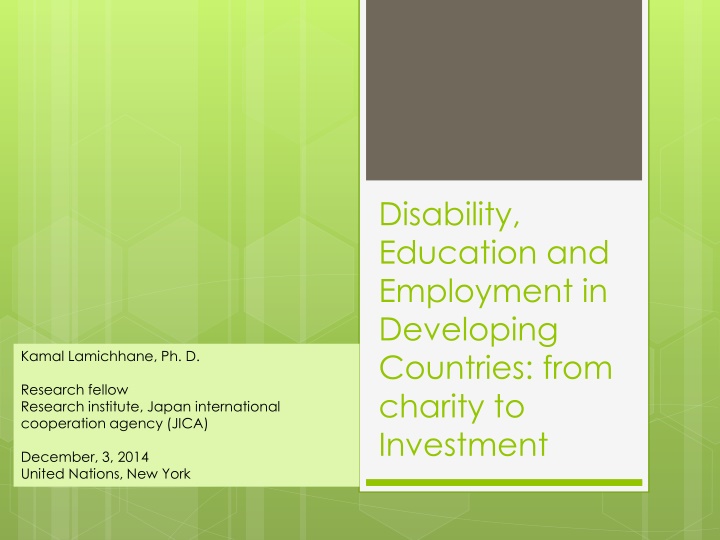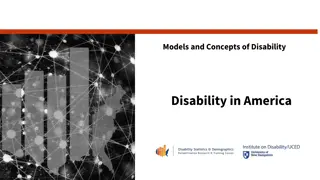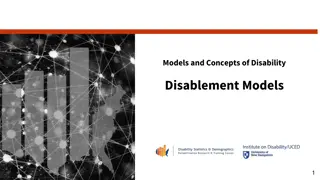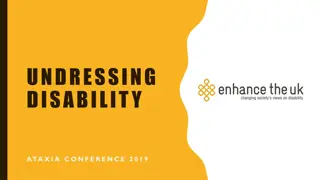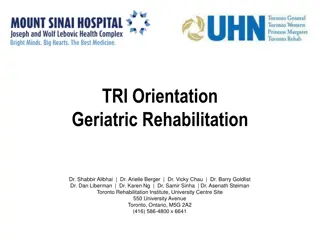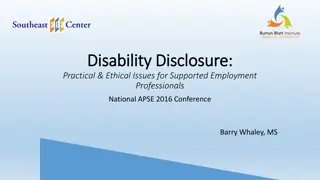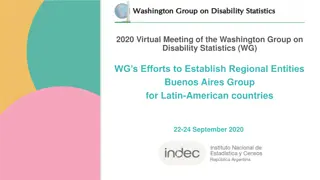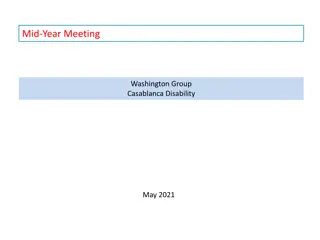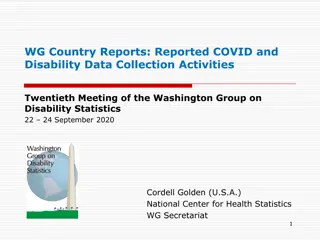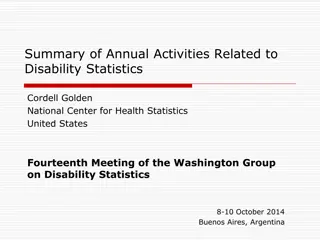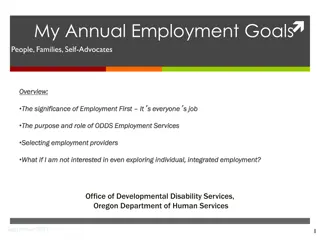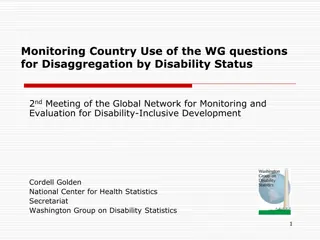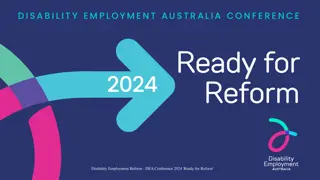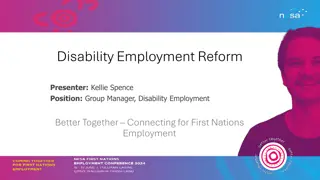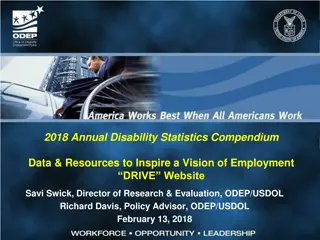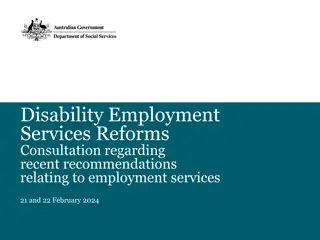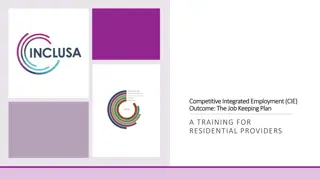Disability, Education, and Employment in Developing Countries: A Focus on Empowerment
This book addresses the challenges faced by people with disabilities in developing countries, exploring the impact of education on social inclusion and economic empowerment. It aims to fill the gap in understanding the barriers to schooling and employment, providing evidence from Nepal, India, Bangladesh, Cambodia, and the Philippines.
Uploaded on Mar 15, 2025 | 2 Views
Download Presentation

Please find below an Image/Link to download the presentation.
The content on the website is provided AS IS for your information and personal use only. It may not be sold, licensed, or shared on other websites without obtaining consent from the author.If you encounter any issues during the download, it is possible that the publisher has removed the file from their server.
You are allowed to download the files provided on this website for personal or commercial use, subject to the condition that they are used lawfully. All files are the property of their respective owners.
The content on the website is provided AS IS for your information and personal use only. It may not be sold, licensed, or shared on other websites without obtaining consent from the author.
E N D
Presentation Transcript
Disability, Education and Employment in Developing Countries: from charity to Investment Kamal Lamichhane, Ph. D. Research fellow Research institute, Japan international cooperation agency (JICA) December, 3, 2014 United Nations, New York
Background 15% of the world's population have some form of disability (World Report on Disability, 2011) 80% of them live in developing countries, making the worldwide disabled population collectively one of the poorest and most marginalized segments of society (ILO, 2007; UN 2006; UNDP, 2006) Significant shift in approaches to disability: Historically, people with disabilities were treated as passive recipients of support based on feelings of pity During the civil rights era of the 1960s and 70s, a wide variety of strategies and programs intended to affect a shift from policies based on exclusion, with targeted charities, toward policies embracing persons with disabilities were introduced worldwide (Cook and Burke, 2002) A paradigm shift from the medical model to the social model of disability UN Conventions of the Rights of Persons with Disabilities (adopted by the UN General Assembly on Dec 13, 2006)
Background (contd.) Numerous studies on the importance of investment in education for people without disabilities since the late 1950s (Card, 1999, 2001; Heckman et al., 2006; Psacharopoulos and Patrinos, 2004) However, it is still unclear: To what extent disability-inclusive development programs have been successfully implemented in developing countries. What is the effect of education for their social inclusion and economic empowerment? What are the obstacles of schooling and employment of them? How the government can design effective policies for their full and equal participation?
Purpose of the book The questions above are still not answered properly Lack of empirical studies on the human capital formation for disabled people particularly in low and middle income countries This book aims to at least partially fill this lacuna in existing knowledge by providing evidences on the returns to the investment in education, the effect of education on the labor market participation poverty reduction the barriers to both employment and education by the cases of Nepal, India, Bangladesh, Cambodia and the Philippines
Contribution of the book The empirical works in this book will be important assistance for the governments and international agencies to design policies toward mainstreaming disability in the development efforts.
Data and methods Together with primary dataset collected, nationally representative datasets of Asian countries are used Econometric techniques are employed for returns to education and to examine effect of education on employability, jobs satisfaction, poverty and determinants of schooling Qualitative interviews and thematic content analysis are used to capture further information on barriers to education
Disability and returns to education (Nepal) Returns to education (percent) % 10 9 8 7 6 5 4 3 2 1 0 World OECD Asia Source: Psacharopoulos and Patrinos (2004)
Disability and returns to education (Nepal) (contd.) Estimation results of earnings regression (dependent variable: log hourly wage)
Disability and barriers to employment People with disabilities are marginalized in labor market participation They are hired last and fired first generally Disabling barriers: perceived lower productivity, discriminatory attitudes, lower level of education, lack of training programs, lack of reasonable accommodation provisions, inaccessible infra-structures, wage disparity
Nexus of education to employment (Bangladesh) Regression results of employability and occupational choice for total sample (1) (2) Base outcome: Not working Working -0.798*** (0.004) 0.004*** (0.000) -0.035*** (0.006) 0.002*** (0.000) -0.004 (0.007) -0.038** (0.017) -0.046** (0.021) -0.206*** (0.051) -0.098* (0.055) -0.189*** (0.056) -0.079*** (0.018) -0.232*** (0.032) -0.013*** (0.004) -0.053*** (0.004) 0.027*** (0.009) 29622 Base outcome: Day labour Variable Dummy = 1 if female Self-employed -0.043*** (0.008) 0.004*** (0.000) 0.133*** (0.014) 0 (0.001) 0.041*** (0.015) -0.058* (0.034) -0.001 (0.037) 0.138 (0.096) 0.224 (0.143) -0.05 (0.139) -0.038 (0.030) -0.07 (0.049) 0.196*** (0.009) 0.030*** (0.011) 0.250*** (0.021) 15331 Employee 0.114*** (0.007) 0 (0.000) -0.115*** (0.012) 0.027*** (0.001) -0.009 (0.012) -0.009 (0.028) -0.025 (0.031) -0.076 (0.070) -0.116 (0.095) 0.1 (0.137) -0.037 (0.024) -0.007 (0.040) 0.044*** (0.007) -0.025*** (0.008) -0.122*** (0.017) 15331 Age Married Years of schooling Visual impairment Hearing impairment Physical impairment Cognitive impairment Difficulty in self-care Difficulty in communication Dual impairment Multiple impairment Log monthly expenditure Dummy = 1 if remittance Dependency ratio Number of observations
Nexus of education to employment (Bangladesh) (contd.) Regression results of employability and occupational choice (disability only) (1) (2) Base outcome: not working Base outcome: day labour Variable Dummy = 1 if female Working -0.744*** (0.013) 0.002*** (0.001) -0.042** (0.021) 0.006*** (0.002) -0.126*** (0.022) -0.009 (0.013) -0.052*** (0.014) 0.120*** (0.032) 2957 Self-employed -0.094*** (0.024) 0.006*** (0.001) 0.212*** (0.041) 0 (0.003) -0.109*** (0.042) 0.190*** (0.025) 0.075** (0.029) 0.224*** (0.059) 1829 Employee 0.107*** (0.021) -0.001 (0.001) -0.146*** (0.041) 0.027*** (0.002) 0.087** (0.039) 0.038** (0.019) -0.027 (0.022) -0.123*** (0.046) 1829 Age Married Years of schooling Severity of impairment Log monthly expenditure Dummy = 1 if remittance Dependency ratio Number of observations
Life changes resulting from employment (Nepal) Any changes after getting a job? Yes No 95.42 4.58 Life changes experienced Spending time efficiently Increased living standard Gaining respect from people Increased confidence to face challenges Making new friends Discovering new abilities 60.70 65.50 54.15 62.45 66.81 51.53
Barriers to Education (Nepal & India) Visual 7.1 (15) 3.3 (7) 2.3 (5) 0.9 (2) 1.9 (4) Hearing 18.2 (39) 21.0 (45) 11.2 (24) 15.4 (33) 1.4 (3) Physical 14.9 (32) 1.4 (3) 8.9 (19) 4.7 (10) 0.4 (1) Total 40.2 (86) 25.7 (55) 22.4 (48) 21.0 (45) 3.7 (8) Barriers Financial difficulty Lack of school support Other barriers * Lack of available schools Rejected by schools Total (number of observations) 214 * Communication difficulty, inaccessible school infrastructure, and school being far from home
Education & Parental Attitudes (Nepal) Average years of schooling by parental attitudes Awareness of disability issues Understanding of rights of people with disabilities Attitude toward abilities of people with disabilities Parental attitudes Very high/positive 10.3 9.7 10.6 High 9.7 10.9 9.9 Moderate 8.3 8.8 8.6 Low 7.6 7.5 5.7 Not at all/negative 5.7 7.2 7.2 Total (number of observations) 203
Concluding remarks Persons with disabilities are poorer and face more inequality To reduce poverty and inequality and achieve inclusive and sustainable development, give equal footing to the issues of those with disabilities In Post 2015 development goals, people with disabilities should not be left behind Exclusion of disabilities makes the society more vulnerable
Concluding remarks (contd.) Paradigm shift: 1. From exclusion to inclusion 2. From sympathy to rights 3. From charity to investment
